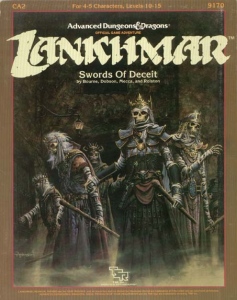Swords of Deceit
 | |
| Code | CA2 |
|---|---|
| TSR product code | 9170 |
| Rules required | Advanced Dungeons and Dragons,1st ED |
| Character levels | 10 - 15 |
| Campaign setting | CA |
| Authors | Stephen Bourne,Ken Rolston,Steve Mecca,Michael Dobson |
| First published | 1986 |
| Linked modules | |
| CA1,CA2 | |
Swords of Deceitis a 1986adventure modulefor theAdvanced Dungeons & Dragonsfantasyrole-playing game,for theLankhmarsetting.
Plot summary[edit]
Swords of Deceitcontains three magazine-sized scenarios for theLankhmarsetting, the first of which is called "The Curse of Valinor".[1]In this scenario, theplayer charactersbecome involved in intrigue between the nobles of Lankhmar.[2]The second scenario, "Return of the Rats", is a continuation ofThe Swords of Lankhmar,in which the characters must find the missingFafhrd and the Gray Mouser.[1]The player characters become shrunk and enter the Rat Kingdom of the Undercity to find Fafhrd and the Gray Mouser.[2]The third scenario, "One Night in Lankhmar", begins in a gambling den.[1]In this scenario the player characters must deal with gamblers, assassins, and illusions.[2]
This 10th to 15th level adventure is designed for theLANKHMAR City of Adventuresetting and theAdvanced Dungeons & Dragonsgame. It cannot be played without theLankhmar City of Adventurebook or theAD&Drules published by TSR, Inc.
Publication history[edit]
Swords of Deceitwas designed by Stephen Bourne,Michael Dobson,Steve Mecca, andKen Rolston,with cover art byKeith Parkinson,and was published byTSRin 1986 as a 40-page booklet with a color map and an outer folder.[2]According to the module cover, it is intended for 4-5player charactersof levels 10-15.
CA2is the second module published intended to be used with the campaign packLankhmar - City of Adventure.This module contains a 40-page scenario booklet, five pre-generated characters, and a full-color map of the city (including its main sewers).[1]
Reception[edit]
Graeme DavisreviewedSwords of DeceitforWhite Dwarf#82. Davis felt that the suggested levels for PCs were too high, and should have been more like 7-10; he suspected that this was done "so that Fafhrd and the Grey Mouser could be used", and had "a sneaking suspicion that American produced modules are written with a few levels of slack in them, so that it's possible to take theRamboapproach ".[1]
Of the scenarios, Davis called "The Curse of Valinor" a "strong tale about skeletons in the closet coming home to roost, with a mini-dungeon which is slightly hackneyed and a bit too helpful", pointing out that the monster's tomb contains a book which explains the whole story.[1]He found "Return of the Rats" excellent with good role-playing opportunities and niceNPCcharacterization, although he found the sewer system in the scenario disappointing and illogical. Davis' favorite was "One Night in Lankhmar", stating that "No matter where your players have been or what they've done, they will never, ever forget this one. They'll probably never work out what's going on, either The whole thing is beautifully set up to leave them with the uneasy feeling that they've just clipped the edge of something really big."[1]
Davis declaredSwords of Deceitto be very good, "for an experienced DM with a group who are used to demanding and thoughtful adventures with the accent on role-playing".[1]
See also[edit]
References and Footnotes[edit]
- ^abcdefghDavis, Graeme(October 1986). "Open Box".White Dwarf(82).Games Workshop:4.
- ^abcdSchick, Lawrence (1991).Heroic Worlds: A History and Guide to Role-Playing Games.Prometheus Books. p. 88.ISBN0-87975-653-5.
